- Home
- A day in the teaching life of...Sarah Mathews
A day in the teaching life of...Sarah Mathews

I arrive at my school, Brisbane Bayside State College, before 7am to get some paperwork done, finalise my lesson planning and discuss the day ahead with my fellow teachers.
At 8am I head to the library for my regular before-school tutorial. There are six students waiting, and as we enter they start asking questions. A few more arrive. The time rushes by before I send the students to roll class at 8.35 am. I quickly visit a few Year 10 classes to meet with students to discuss their mathematics subject choices for next year.
I teach a Year 11 general maths class - this week, we’re working on scatter plots. Every student has their own device, so I explain the task that’s available on the online class notebook, and everyone works at their own place. As always, there are some reluctant learners, but the technology available has really freed my time up to be able to take them to one side and chat to them individually. After they’ve completed the task at hand, they play an online game which feeds data back to me so I can check their understanding.
The second period is my non-teaching time and I respond to emails from students, parents and teachers before attending the college assembly. This year’s theme is “because of her, we can” and we hear from an Aboriginal elder and thank our school Aboriginal and Torres Strait Islander liaison officer for her great work in our school community. Six per cent of our school community is indigenous, and she supports students in and out of class, as well as running a dance group, connecting with parents and facilitating indigenous programmes (sport, cultural and academic).
There are some great initiatives for indigenous students in Queensland schools. Aboriginal identity is recognised with an elected indigenous student leader, and “welcome to country” at all school assemblies.
Then, I head straight to playground duty. I chat to students as they arrive at the basketball court and find out what is happening in their lives. They come from a range of backgrounds: some are disengaged (some with high-level behaviours) and some are academically driven. There are many with special needs, and an increasing number being raised by grandparents or other carers. We chat about lots of things, including football, food, weekend antics, maths and books. The basketball court is a leveller. One thing our school does well is supporting acceptance of difference and provide opportunities for all students to succeed.

When the bell sounds, I rush to my period three class.
Most of my Year 10 advanced maths students are waiting when I arrive. They start the warm-up immediately. We are doing a unit on statistics and I get the class measuring their head circumferences so we can determine if there is a statistical difference between males and females.
One student asks: “What if a student is transgender?”. I reply: “If you are transgender, please put your data in the gender you identify with.” We have a few transgender students at school and our school guidance officer has built awareness of the issues with the teachers and the pupils. This has really helped everyone to be accepting and supportive.
The lesson continues with high energy, and I link the learnings to the upcoming assignment before the bell disrupts us. Students stay seated quietly whilst I conclude the lesson. In fact, five students remain for much of the lunch break, to ask questions about the work or just to draw on the whiteboard. I calm an anxious high-achieving student and ensure I have time to chat to a student who I know is troubled at home. Students face significant challenges from not getting on with parents or step-parents to witnessing drug usage and violence.
Even though I have high expectations in my classes the student pressure to get high grades is either internal or driven from parents. The majority of our students do not go to university. We cater for them by providing the opportunity to undertake traineeships, school-based apprenticeships and complete certificate courses whilst in school.
As the bell signals the end of the day, teachers arrive back in the staffroom. Some are excited by a great lesson, others are asking for advice about tricky students. I head to the leadership meeting, where the focus is all about building teacher capability.
After the meeting, I spend 20 minutes contacting parents by phone and email. I end my day by writing three positive postcards for students who have started the term with an improved attitude to learning.
The work as a teacher in Australia is draining. There are significant hours spent outside of the classroom to plan for a national curriculum, undertake mandatory training and meet the Australian teacher standards. The only way to manage is with team planning, there really is a lot of power in collaboration.
Sarah Matthews is a maths teacher at Brisbane Bayside State College, Australia.
Do you want to tell the world’s teachers about your working day, the unique circumstances in which you teach or the brilliance of your class? If so, email kate.parker@tesglobal.com. We will give your school £100 if your story is published.
Keep reading for just £1 per month
You've reached your limit of free articles this month. Subscribe for £1 per month for three months and get:
- Unlimited access to all Tes magazine content
- Exclusive subscriber-only stories
- Award-winning email newsletters